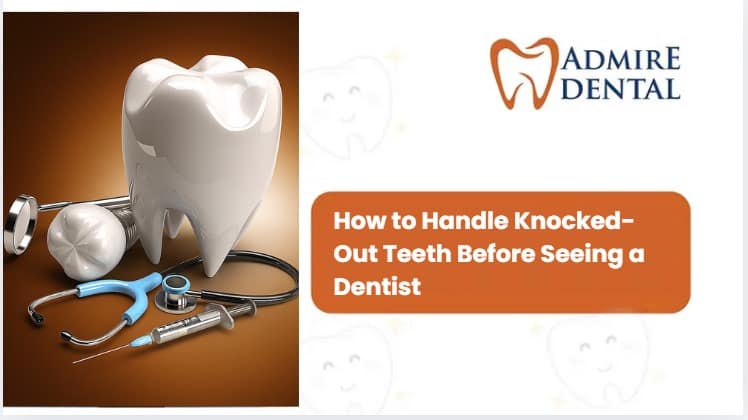A tooth that is knocked out is among the most frightening dental emergencies. And the way you deal with it within the initial minutes can be the difference between saving the tooth or losing it forever. It could be caused by a sports accident, fall, or an unexpected impact. An immediate and swift action is essential. The positive side? By following the correct steps, a damaged (avulsed) tooth is likely to be successfully restored with the help of your dentist. Knowing what to do as well as what to avoid doing prior to seeking professional help will greatly improve the outcome.
1. Stay Calm and Assess the Situation
The most crucial step to take after the tooth is knocked out is to be at peace. A frightened reaction can stall action and it is important to take your time and ideally the tooth that has been knocked out should be restored within 30 minutes to one hour. Make sure you know if the tooth is a newborn, or one that is permanent. Baby teeth cannot be reimplanted however permanent teeth are often saved by immediate treatment.
2. Find the Tooth and Handle It Carefully
If you find the tooth, place it with the crown the visible, white portion that you typically observe within your mouth. Be careful not to touch the root (the part that is yellow) because it’s covered in delicate cells that help to reattach the tooth to bone. The root’s handling can decrease the chance of a the reimplantation process going smoothly. If the tooth fell onto a surface that is dirty beware of the desire to scrape or scrub it clean. This could cause damage to the roots cells.
3. Gently Rinse, Don’t Rub
If your tooth is stained you can gently clean it using water or saline. Pure water can also be used in an emergency situation, however, you should avoid alcohol, soap or other chemicals. Don’t scrub or dry the tooth using a towel or a cloth. The aim is to ensure that the tooth remains hydrated and healthy while getting rid of visible debris, but without damaging the natural tissue of the root.
4. Try to Reinsert the Tooth (If Possible)
If you are confident and the person you are speaking with is aware, attempt to insert your tooth into the socket right away. Simply push it back into its socket and gently press it against gauze or a clean cloth to secure it. This is typically the best method to ensure the tooth’s health until you can visit the dentist. But if you’re not sure or the patient is suffering excessive pain, avoid this step and focus instead on making sure the tooth is kept dry.
5. Keep the Tooth Moist at All Times
A tooth that is knocked out must never be allowed to dry out since this drastically lowers the chance of survival. If reimplantation isn’t an option put the tooth in one of these ways:
- Milk: milk is the best alternative that is easily available as it keeps the roots’ cells active.
- Saliva: Let the person gently place the tooth in their cheek (only when they are alert and conscious).
- Saline or tooth preservation solutions Certain pharmacies sell emergency tooth preservation kits such as Save-A-Tooth(r).
Do not place teeth in water over prolonged durations as it may cause damage to the root cells.
6. Control Bleeding and Manage Pain
When a tooth is removed bleeding can be common however, it is usually stopped with gentle pressure. The patient should bite gently on a gauze pad or a clean cloth. Apply a cold compress on the cheek to ease swelling and discomfort. Avoid taking aspirin since it may cause bleeding. Instead, opt for ibuprofen or paracetamol when required.
7. Get to the Dentist Immediately
The speed of your response is the most important aspect in preserving a damaged tooth. Make sure to visit either your dental professional or an emergency facility in 30 to 60 minutes. The faster the tooth can be restored, the better the likelihood of a the successful healing. Contact them ahead of time to let them know that it’s a dental emergency. This enables the team to plan for treatment immediately.
8. What Your Dentist Will Do
When you get there the dentist will:
- Cleaning and disinfecting the socket.
- Replace the tooth and then stabilize the tooth with an tooth splint.
- Examine X-rays for the condition of your bone or tissues.
- Give antibiotics or a tetanus booster if you are required.
In the coming weeks your dentist will keep track of the healing process and suggest root canal therapy to ensure longevity.
9. Caring for the Reimplanted Tooth
Following your reimplantation Your dentist will give specific instructions for aftercare. Typically, you’ll be instructed to follow the following steps:
- Take soft food snacks for a few days.
- Do not bite directly on the tooth that is affected.
- Maintain a gentle oral hygiene with an easy-bristled, soft-bristled toothbrush.
- Follow-up visits are a good way to track the progress.
Careful and appropriate treatment during the period of healing will allow the tooth to integrate effectively to the jawbone.
10. Preventing Future Dental Injuries
While injuries can’t be always avoided, implementing precautions can lower the likelihood of tooth damage:
- Wear a mouthguard while participating in sporting activities or other physical.
- Beware of using teeth to break open packages or to bite hard objects.
- Keep your mouth healthy and strongHealthy gums and bones help strengthen teeth.
- Your home should be childproofed when you have toddlers who are who are learning to walk.
Be proactive and you’ll be the best method to protect your smile.
The Psychology Behind Dental Emergencies
Dental trauma is often a trigger for panic, anxiety and embarrassment particularly when it occurs in sports or in public. Knowing how to handle the situation in a calm manner can lessen anxiety and lead to better results. Being aware of the steps you need to take before time, such as preserving the tooth and getting to the dentist promptly will give you a sense control in stressful situations. For children, being relaxed can make a huge difference in the way they deal with dental emergency situations emotionally.
Conclusion: Quick Action Saves Smiles
A tooth that is knocked out doesn’t need to be that you’ve lost your smilehowever, the secret lies in getting it fixed quickly and efficiently. Take care when handling the tooth ensure it is kept moist and visit your dentist as soon as you can. Every second counts when it comes down to the success of reimplanting your tooth. Keep in mind that dental emergencies could happen to anyone, however knowing what to do can turn an anxious moment into a period of calm. A quick response could be the difference in saving a natural toothwhich is every time worth the effort.
FAQs
-
Can a tooth knocked out really be saved?
If handled correctly and reimplanted in 30-60 minutes, a lot of knocked-out teeth are able to be saved.
-
Do I need to put a baby tooth back into its socket?
No. Baby teeth shouldn’t be reimplanted as it could damage the permanent tooth beneath.
-
Do I wash a knocked-out tooth using tap water?
Just briefly if an alternative solution is available, long-term exposure to water may cause harm to the root cells.
-
What happens if I’m unable to locate the tooth that was knocked out?
Consult your dentist right away The X-rays will ensure that there are no pieces of debris within the socket.
-
How can I reduce the risk of dental injury?
A mouthguard that is worn, avoiding chewing on hard objects and maintaining a healthy oral hygiene will help avoid future accidents.



